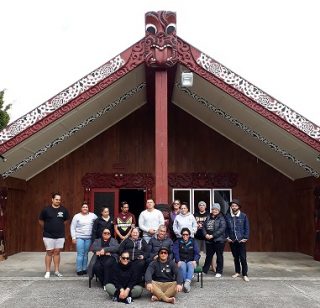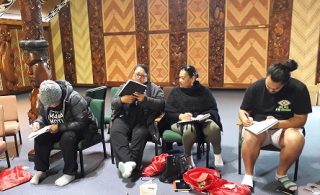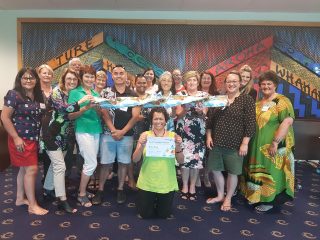Case Study: How Te Wānanga o
Aotearoa Evolved Education
By Ruhia King, Master TetraMap Facilitator from Te Wānanga o Aotearoa
All around the globe, TetraMap Facilitators are enablers – trained to unravel the complexity of human behaviour in ways that celebrate our natural diversity. Not only does TetraMap unite people using a set of tools that help them learn from one another, it also creates sustainable business solutions to achieve tangible performance results.
This inspiring, courageous journey delves into the transformation of the world’s largest indigenous tertiary institute – Te Wānanga o Aotearoa in New Zealand. Here they used TetraMap to develop a unique indigenous communication model that supports cultural diversity, fosters stronger leadership and deepens the educational experience for both tutors and students.
Re-Imagining Education
Originally constructed by a group of expelled students on what used to be a rubbish dump, and paid for by founders who believed the organisation was so vital that they mortgaged their homes to make it happen, Te Wānanga o Aotearoa quickly established itself as a credible tertiary education alternative in New Zealand.
Ever since it began, when the roll was just 20 students, this education provider has been deeply committed to helping those disenfranchised by the mainstream education system. Fast forward 30 years and Te Wānanga o Aotearoa is not only the second largest tertiary provider in Aotearoa – New Zealand but also the largest indigenous tertiary institution provider in the world.
Its success is largely attributed to the institution building strong relationships with iwi (Māori tribes) and its communities. Today, it offers a range of certificate, diploma, degree and Masters level qualifications to over 30,000 graduates.
The original building, Otāwhao Marae, was opened on 27 April 1985 and still stands on the college grounds. Today it is used as a resource to reveal the history, philosophy and principles to its students and staff. While Te Wānanga o Aotearoa’s past is respected, the institution has also used new tools to help it rapidly evolve.
The Institute’s ability to seemingly effortlessly celebrate cultural diversity is seen globally as a key to its success.
TetraMap Certified Master Facilitator and Manager Ruhia King – the manager of Ako Wānanga
(Practice of Excellence) development and delivery practices in the institution – believes a lot of that comes down to their adoption of TetraMap and the programme’s versatility.
“I like to know how people think/behave. TetraMap had the Instrument which could be readily used which means I didn’t have to develop our own entirely from scratch,” she says.
Supporting the indigenous perspective

Ako Wānanga is the unique framework that Te Wānanga o Aotearoa uses. At the heart of Ako Wānanga is a commitment to nurturing transformative education and ako (teaching and learning) experiences.
Supported by its founders Yoshimi and Jon Brett, Ruhia has made it her mission to align TetraMap with an indigenous perspective. To do this, she has customised the TetraMap to work alongside Te Wānanga’s own version of the instrument, creating a development tool, especially for Te Wānanga O Aotearoa’s unique learning environment.
“As an indigenous culture, we naturally connect to nature when we get caught up in mainstream teaching. In one of our classrooms, it’s crucial to engage with different cultures. There is a saying “don’t teach me my culture, but use my culture to teach me”. That phrase is used a lot at Te Wānanga,” explains Ruhia.
“We have a relationship with Jon and Yoshimi Brett and now have a memorandum of understanding which allows us to use the TetraMap tool alongside our own delivery context. I would think we are the first tertiary provider that has that.”
The institution was vital in supporting Ruhia’s development to first become a Master TetraMap Facilitator. This has meant she’s been able to train the Ako Wānanga team to become Certified TetraMap facilitators (CTFs). Te Wānanga o Aotearoa now has 7 CTFs and want to train more staff.
The Ako Wānanga team supports all staff in their pursuit of excellence – particularly the 640 national tutors that make up the teaching staff. As part of each tutor’s development, they attend Ako Wānanga workshops which use a revised version of the TetraMap Instrument, specifically designed for Te Wānanga o Aotearoa. This approach has culminated in a wide variety of ways an indigenous approach to TetraMap is used by tutors, both inside and outside the institution.
Sharing the same values
The reason TetraMap resonates so much and has been transformational for Te Wānanga o Aotearoa’s cultural diversity is that it speaks to similar principles of an indigenous model Te Tapa Toru (see the model on the last page). This was passed down to Ruhia from her grandparents and parents.
“We were never taught about this at school, we were not allowed to learn about our own culture or our language. Connecting with the environment is a natural part of my culture,” explains Ruhia, who has modified TetraMap’s My Nature Your Nature Instrument. This has meant Te Wānanga o Aotearoa has been able to use it to assist its tutors to identify their unique teaching and assessment preferences.
For example, if the tutor is high Earth, the model helps to ensure they fully consider other preferences when assessing.
“When I talk about my genealogy we’ll talk about our land, our mountain, our waters, our wind and the sun. Where I come from my Hapū name is Ngāti Mahuta ki Te Hauāuru that means my tribe is Ngāti Mahuta from the westerly winds and coast Te Tai Hauāuru. I have used TetraMap in so many different situations – to develop my tribe’s charitable trust constitution, to train Trustees who are responsible for land and family trusts, and even in acquiring my Masters in Indigenous Practice qualification.”
While Ruhia explains that Te Tapa Toru will “always be with me”, it is the support of the TetraMap whānau (family) that is enabling her to take her Māutauranga (knowledge) and Mōhiotanga (skills) to another level to drive and evolve Te Wānanga o Aotearoa’s teaching philosophy.
Creating a diverse learning environment for all

Using TetraMap throughout the institution has helped create a place where every person – tutor or student – can actively learn together by adopting a variety of different styles.
Ruhia knows that by continuing to foster this process, others at Te Wānanga o Aotearoa and its wider stakeholder communities will also get to experience the mana (prestige) of the programme – something she felt the moment she first encountered the TetraMap team at an Auckland marae in 2011.
“It was while waiting outside the gates at the Marae that I met Yoshimi, Jon and Louise. I explained the protocols of entering the Marae, and led them through the process.”
What was also exciting for Ruhia was meeting two beautiful Mana Māori wāhine (strong Māori women) Kataraina Pipi and Marcia Cassidy, who facilitated her TetraMap training. “That stirred the fire in me to become a Certified TetraMap Facilitator and then later becoming a Master TetraMap Facilitator”.
After becoming a facilitator, Ruhia began adding bespoke touches from Māori culture to the Instrument and met with Yoshimi and Jon Brett to show what she had done. They approved because it worked.
“I use TetraMap in all of the training that I do,” says Ruhia. “Every week I’m training at one of our 52 sites nationally. The tool allows you to put yourself in an assessor space and give an indication of how as assessors they are likely to assess students.”
Contextualising the learning is crucial to teaching

Whenever she trains tutors using this approach, she says every tutor finds it easier to understand and contextualise their own educational environment.
“I have to think about what that class is like, what specifically they are teaching. For example, carving, weaving, language, computing – there is a diverse range of programmes with their own unique learning,” explains Ruhia. “My first training in Te Wānanga was for a security team who check all the sites nationally and I had to really look at their environment to make it conducive for them.”
Combining Māori and TetraMap insights is also vital for the way Ruhia plans the teaching strategies needed for each individual class.
It also helps Te Wānanga o Aotearoa’s development as a whole community – one that respects every individual and their behaviour and insights.
“There is learning in everything we do, and reflecting on the good and bad experiences provides an opportunity to seek knowledge and master the experience. Having a moment to stop and think in Māori is known as āta,” explains Ruhia. “Using TetraMap allows everyone to engage, āta before you react to a situation.”
Most importantly, however, it brings together the physical and the spiritual and teaches people to “look twice, think twice and take two breaths before you speak”.
“You only have one mouth and one opportunity to say it with truth and belief,” says Ruhia. “You need an aata moment, to stop and identify different contexts allowing you to dial up and dial down. This is how we’ve managed, and will continue to provide holistic educational learning of the highest quality for Māori, the peoples of Aotearoa and the world.”
Te Tapa Toru - an indigenous model
Download 39.77 KB 176 downloadsIn July 2017, Ruhia presented the story of Te Wānanga o Aotearoa and its connection to TetraMap at the World Indigenous Peoples Conference for Education in Toronto, Canada. Ruhia says It was an honour for her presentation to be selected from over 1000 applicants.